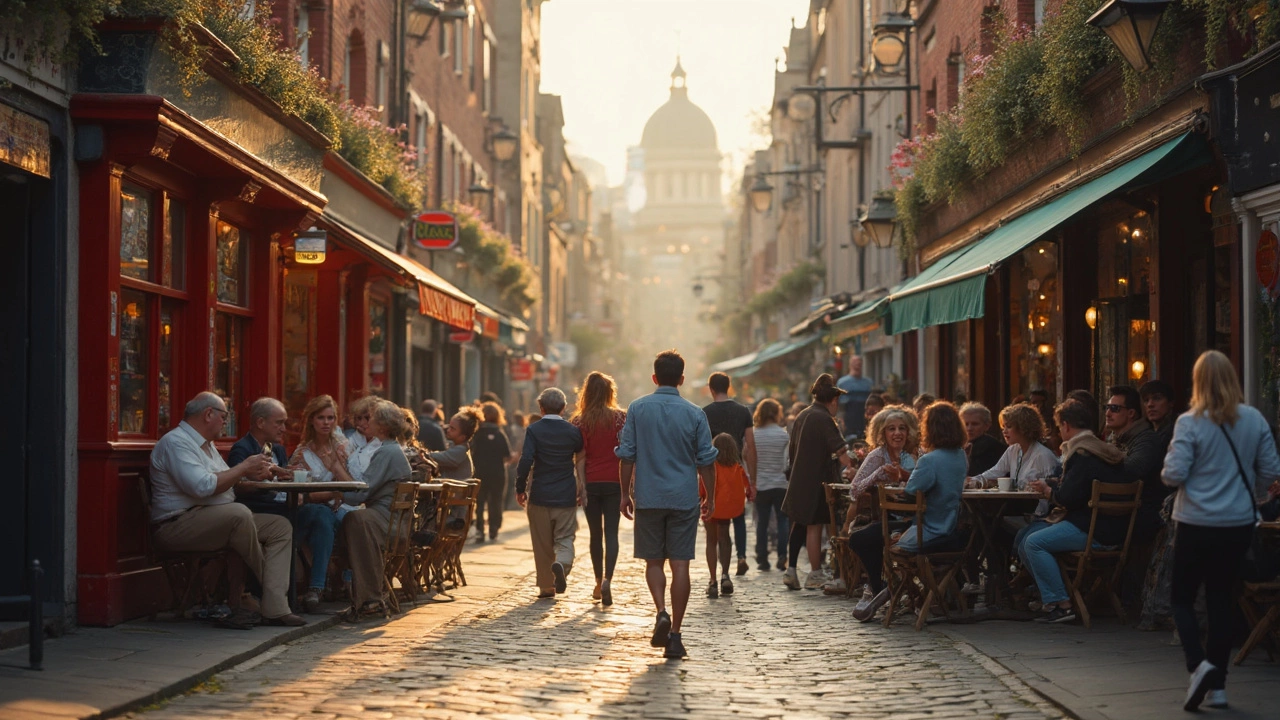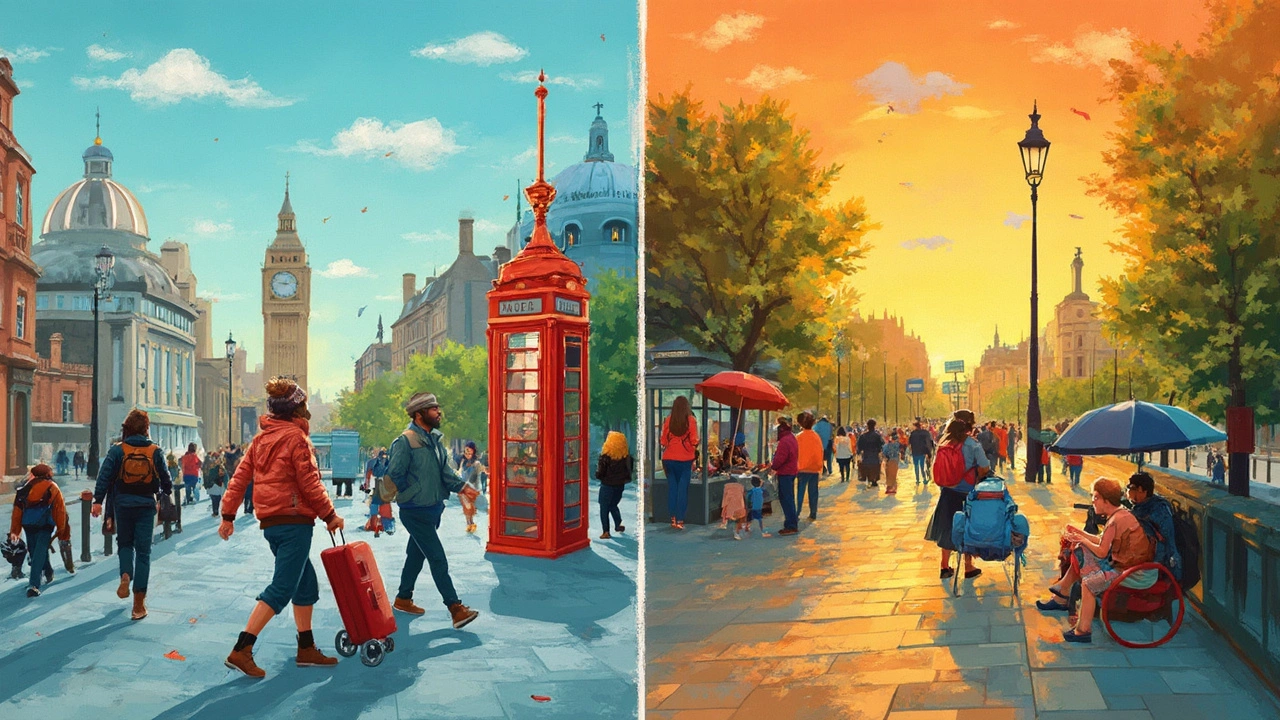How Long Should a City Break Be? Real Talk on Planning the Perfect Trip
 Apr, 26 2025
Apr, 26 2025
You’ve probably stared at booking sites wondering: how many days does a city really need? One night? A long weekend? A whole week? It’s easy to get it wrong—either cramming too much in and ending up wiped out or staying so long that you run out of things to do (and rack up extra hotel bills you could have saved).
The truth is, there’s no one-size-fits-all answer. Some cities beg for just a quick taste, while others have layers you’d miss if you only stuck to the tourist checklist. The trick is matching the city’s vibe—and your own style—to the length of your stay. Do you love hitting landmarks lightning-fast, or prefer blending in with the locals at coffee shops and parks?
Not every city break works on the same 48-hour formula. Factors like travel time, opening hours, and even local culture can totally change your experience. You want to leave feeling like you’ve actually tasted the place, not just snapped photos and run. That means balancing smart planning with space for a little spontaneity. Let’s get into what really makes the perfect city break, and how to choose the right length for you.
- What Makes a Good City Break Length?
- Pros and Cons of Short and Long City Breaks
- Tips to Make the Most of Any Timeframe
- How Different Cities Change the Game
- Mistakes to Avoid When Planning
What Makes a Good City Break Length?
Picking the right city break length is all about what you want out of your trip. Want to cram in big museums, neighborhood strolls, and late-night food hunts? Or just hit a couple highlights and relax? Time, money, and energy—those three shape every city escape.
Here’s a quick rundown of what really matters:
- Non-stop flights and easy travel connections: The less time you spend getting there, the more time you get on the ground. If you lose half a day on each end, even a three-day break shrinks fast.
- City size and must-sees: Tiny cities like Bruges or Ghent in Belgium are compact—most people cover the best bits in one to two days. Big cities like London or Rome, though? You’ll barely scratch the surface in three.
- Pace and personal style: Are you a go-go-go type, or do you hate schedules? Some travelers love a packed, hour-by-hour plan. Others feel happier just wandering. The right city break length fits your speed.
- Opening hours and local habits: In some spots, museums close early or most things are shut on Sundays. That can eat into what you can see. Always check before you go.
- Budget concerns: More days usually means a bigger budget, but it also gives more flexibility. If you hit just the main things in two days, you can splurge on a nice dinner. With four days, you may need to pace your spending.
Most travel surveys show city trips average between 2.5 and 4 days. Here’s a snapshot from a 2023 European travel study:
| Typical City Break Length | % of Travelers |
|---|---|
| 1-2 days | 31% |
| 3-4 days | 55% |
| 5+ days | 14% |
So, the sweet spot? For most people, a city break lands at three days—long enough to catch the vibe, short enough to keep it exciting. But if you’re crossing oceans or hitting giant cities, add a little more time, especially if you want to avoid that rushed, "did I even see anything?" feeling.
Pros and Cons of Short and Long City Breaks
Choosing between a quick hop and a longer getaway isn't just about your calendar—it changes the whole experience. Both short and long city break styles have clear perks and downsides, and knowing them can save you from regret, wasted money, or just feeling burned out.
Short city breaks—think 1-3 nights—are great when you want a change of scenery but don’t want to use up too many vacation days. Traveling within Europe, for example, cities like Paris, Amsterdam, and Prague are perfectly sized for a weekend blitz. Quick trips keep costs down and let you dodge that weird restless feeling you sometimes get after too long in one spot. Plus, if you’re flying budget airlines, you can usually swing these with a backpack, skipping checked-luggage fees entirely.
- Less time off work or away from commitments
- Fewer hotel nights = more budget for dining or activities
- Lower risk of getting bored or homesick
- Encourages focused exploring—no time to waste
But it’s not all smooth sailing. The biggest drawback? Everything feels rushed. If your flight gets delayed, you lose precious hours. You might miss local restaurants or attractions that close early. Jet lag can cost you half a day if you’re crossing time zones. And honestly, you’re probably not blending in with locals; you’re just sightseeing in fast-forward.
- Risk of travel delays eating up a big chunk of the trip
- No room for relaxation or spontaneous exploring
- Only time for top tourist spots, not hidden gems
Long city breaks—4 days and up—let you slow down and settle in. You can visit museums one day and just wander neighborhoods the next. Cities like Rome, London, or Berlin are famous for having so much to offer that a couple of days doesn’t even scratch the surface. With extra time, you can try local food at your own pace, book guided tours, or even take day trips out of town.
- More relaxed pace—less rushing and more memories
- Chance to discover neighborhoods, not just tourist spots
- More flexibility if something goes wrong (bad weather, late arrivals)
- You can fit in local events or festivals
Still, longer trips cost more in hotels and meals. There’s a genuine risk of sightseeing fatigue, where everything starts blending together, and you stop really noticing new things. And unless you plan smart, you might feel like you’re just killing time to fill your days.
- Bigger travel budget needed
- Can lose energy or excitement after first few days
- Possible to run out of must-see spots in smaller cities
To give you a quick look, here’s a comparison based on European city break data:
| Trip Length | Average Spend/Day (€) | Popular Cities | Most Visited Attractions |
|---|---|---|---|
| 2-3 Nights | 160 | Prague, Budapest, Vienna | Main squares, museums, local markets |
| 4-5 Nights | 145 | London, Paris, Rome | Neighborhood tours, day trips, special events |
If it’s your first visit, err on the side of short and sweet unless the city is packed with stuff you’re dying to see. If you’re returning or want to dig deep, give yourself more time—you’ll notice layers most tourists miss.

Tips to Make the Most of Any Timeframe
No matter if you’ve only got one night or a full week, there’s a strategy for squeezing the best out of your city break length. You want to avoid wasting time on aimless wandering or getting stuck in lines, right? Here’s how you carve out real memories, not just blurry snapshots.
- Prioritize your must-sees. Make a list—three things, max, that you’d kick yourself for missing. If you try to do it all, you’ll end up barely remembering anything. Apps like Google Maps and Citymapper help set realistic routes based on your time and location.
- Buy tickets ahead where it counts. Skip-the-line passes aren’t just a scam; they save hours, especially in cities famous for their tourist crowds. In 2023, the Louvre reported average wait times of up to two hours at peak hours—who wants to waste precious time in line?
- Go local with food and transport. Instead of fancy sit-down meals that eat up time, try street food or bakery lunches. Use city bikes or public transit—many cities offer 24 or 48-hour travel passes that make zipping between sights way easier and cheaper than taxis.
- Early starts win. Arrive at big-name attractions first thing in the morning. For example, the Sagrada Família opens at 9 am, but by 11 it’s already packed—even on weekdays.
- Cluster your activities. Don’t criss-cross the city all day. Map out what’s near each other, hit those sights back-to-back, then move on to a new area. This is where planning pays off and lets any weekend getaway feel way longer.
When you’re choosing your city break length, don’t just look at the calendar. Check travel arrival times. A 2-day trip shrinks fast if you hit the city at 3 pm on Friday and leave at noon Sunday. Actual available hours matter more than how many nights you sleep there.
| Number of Days | Recommended Sights/Experiences | Average Walking Distance (km/day) |
|---|---|---|
| 1 Day | 1-2 main sights, local lunch, public square | 8-10 |
| 2-3 Days | 4-6 sights, food market, a museum, evening in historic district | 6-8 |
| 4+ Days | All highlights, offbeat neighborhoods, half-day trips | 5-7 |
And don’t forget to leave a little wiggle room—some of my best city moments have been happy accidents when Ethan and I ditched the checklist and followed our curiosity. Sometimes that local bakery, quiet park, or hidden bookshop is the real star of your trip.
How Different Cities Change the Game
Not all cities are built for the classic two-night city break length. Think about it—flying into Paris, you could fill three days just with the big hitters like the Eiffel Tower, Louvre, and croissants from the first bakery you see. Meanwhile, a place like Bruges or Porto is smaller and more chill; you’ll walk pretty much everywhere, see most of what’s on your list, and have time for a long lunch—all in about 36 hours.
Size is just the start. Some cities demand more just to get from A to B. London’s tube map is famous for a reason—you can spend a day zig-zagging across town, and barely scratch the surface. If you’re heading to Rome, be prepared to get lost in the windy little streets, and remember, you need time for late dinners because locals eat at 9 pm. Meanwhile, in Copenhagen or Vienna, you can cover big ground on a bike or a tram pass, and suddenly a two-day trip feels less rushed.
Let’s talk about museums, too. Madrid’s Golden Triangle—the Prado, Reina Sofia, and Thyssen-Bornemisza—can easily eat up a full day if you’re a fan. Cities like Amsterdam close their museums relatively early, so a quick trip can be perfect if you plan ahead. On the flipside, New York and Barcelona never really sleep; you’ll find something open whatever the hour, so squeezing more into your weekend getaway is possible but you risk running low on energy.
- Long-haul flights: Jet lag is real. Tokyo or New York isn’t great for a short city trip if you spend your first day just recovering from travel.
- Public holidays: Planning Berlin in October? Watch out for public holidays when museums and stores might close or pack out.
- Events and festivals: A summer trip to Edinburgh during Fringe or Munich for Oktoberfest? Triple-check hotel prices and availability—you won’t be the only one eyeing that destination.
Here’s a quick peek at how a few cities compare on classic city break stats:
| City | Must-see Sites | Average Recommended Stay (Days) | Walkability |
|---|---|---|---|
| Rome | Colosseum, Vatican, Trevi Fountain | 3-4 | Moderate |
| Amsterdam | Rijksmuseum, Canal Tour, Anne Frank House | 2-3 | High |
| Istanbul | Hagia Sophia, Grand Bazaar, Bosphorus | 4 | Moderate-Low |
| Bruges | Markt Square, Belfry, Canals | 1-2 | High |
One last thing—let the city set your pace. Some destinations just need a fast dash through the highlights, while others deserve lazy mornings and late-night strolls. Pick the city break length that fits the place, not just your calendar.

Mistakes to Avoid When Planning
Even the best city break plans get tripped up by simple goofs. Let’s talk about what actually messes with a good city break length and how you can dodge the usual traps.
First, packing your days like you’re filming a travel montage is a common error. Trying to do all the sights in a single weekend getaway can leave you too exhausted to enjoy any of them. It’s way better to pick your top three ‘musts’ and leave breathing room for wandering. Real talk—travel burn-out is real, especially when you forget to factor in lines, transport, or that it actually takes time to eat in Europe.
Next: overlooking travel time. Airports on the outskirts, midday hotel check-ins, and train strikes can eat up more hours than you think. I once lost half a day in Paris just navigating from Charles de Gaulle to the city center. Always add a buffer, especially if you’re dealing with airports instead of train stations.
Another slip-up people make is not checking what’s closed. Lots of museums take Mondays off, and in some cities, restaurants shut down on Sundays. In Madrid, even the Royal Palace is off-limits certain days. Always triple-check opening hours so you don’t end up staring at locked gates.
Here are a few other mistakes that can spoil a city trip:
- Skipping pre-booking: Some attractions book out weeks in advance. Popular spots in Rome or Amsterdam? No ticket, no entry.
- Underestimating local holidays: Nothing like getting excited for a festival, only to find transport chaos or crowds everywhere.
- Ignoring public transport quirks: Cities like London and Tokyo have solid transit, but some cities shut down completely at night. Plan how you’ll get home late.
- Not budgeting for extras: Extra nights, city taxes, or pricey last-minute events can bust your budget. Leave wiggle room.
To put things in perspective, check out this quick look at common city break mistakes and how many folks make them, based on recent travel surveys:
| Mistake | % of Travelers Affected (2024) |
|---|---|
| Overplanning daily schedule | 56% |
| Forgetting to pre-book tickets | 38% |
| Not checking local closures | 49% |
| Underestimating commute times | 41% |
| Ignoring budget extras | 33% |
So, if you want your vacation tips to pay off, keep it simple, keep it flexible, and learn from the mistakes that plenty of smart travelers have already made.
